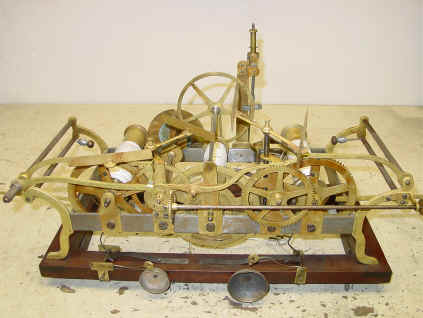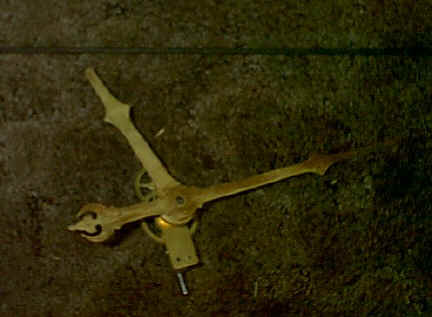


GOTTFRIED
RAHMER, RONDOUT, NEW YORK, USA, c.1850's
Custom, hand made, miniature three train with hour and half hour strike, steel flat bed
design mounted on mahogany wood frame, pinwheel escape with jeweled pallets, helical cut
wheel teeth resulting in only two wheels per train. All screws blued. Harrison style
maintaining power. One second pendulum on wooden rod. 11"h x
21"w x 10"d.








This is quite possibly the only known example of the clock making skills of G. Rahmer
of Rondout New York. The clock was featured in a 4 page article in the National
Association of Watch and Clock Collectors Bulletin, (NAWCC), October 2000; written by
John Darrow, the prior owner of the clock. The clock was likely made in the mid
1800's as the above article cites the advertisements of G. Rahmer Jeweler in the Rondout
Courier of 1855. The Walnut case is 73 inches tall and 17.5 inches deep and is strictly
functional with no real decorative frills except some rippled molding. The movement is
visible on 3 sides, there is a mirror in the back made of incredibly thin (1/16 in) glass
that is surprisingly not broken. The purpose of this clock was to drive a remote
dial and strike hours and quarter hours on remote overhead bells.
The wood case as well as the helical wheeled strike trains and two wheeled going train
are examples of methods used by some German tower clock makers on their full-sized
versions. The reason for this design was to minimize the number of wheels per train in
order to limit errors caused by extra wheels due to oil viscosity and friction. The
negative aspect of this design is the shorter duration time. hence the relatively long
winding barrels. European clock makers usually had their movements mounted in custom made
cases called a "schrank" which is German and roughly translated as
"cupboard". Rahmer was a German immigrant and this model was surely influenced
by his knowledge of German clock making. This is the smallest tower clock I have seen
using this design and surely was built as a demonstration model as it does not have the
power to drive a dial or bells of any conventional tower clock design.



